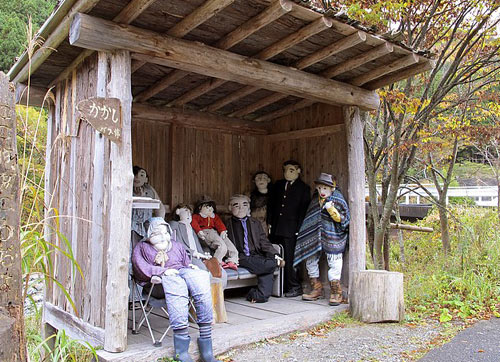
Nagoro is typical of the thousands of communities turning into ghost towns or at best, open-air museums, frozen in time - a trend evident even in downtown Tokyo and in nearly or completely empty villages in the city's suburbs.
Nagoro是成千上万个变为鬼城或露天博物馆的典型社区之一。这种老龄化趋势甚至在东京(Tokyo)市中心和城郊几乎或完全成空的村庄中尤为明显。
The one-street town is mostly abandoned, its shops and homes permanently shuttered.
只有一条街道的小镇几乎被遗弃,商店和房屋被永久关闭了。
With no youngsters left to raise, the local elementary school closed two years ago. Now Ms Tsukimi sometimes guides visitors through the spotless classrooms populated with scarecrow students and teachers.
由于没有年轻人,当地小学两年前就关闭了。现在,月见绫野有时会带领游客参观放满稻草人学生和老师的干净教室。
As Japan grew increasingly affluent after the Second World War, younger Japanese abandoned the countryside, flooding into the cities for jobs in factories and service industries, leaving their elders to tend small farms.
日本在二战(the Second World War)后愈加富裕,日本的年轻人因此离开家乡,涌进城市的工厂和服务行业寻找生计,将他们的老人留在家中务农。
Greater Tokyo, with more than 37million people, and Osaka-Kobe, with 11.5million, account for nearly 40 per cent of the country's 127million people, with another 10million scattered in a handful of provincial capitals.
首都东京拥有超过3700万人口,大阪和神户人口有1150万,几乎占全国1.27亿人口的40%。其它1000万人分布在少量的省会城市。
'There's been this huge sucking sound as the countryside is emptied,' said Joel Cohen, a professor at Columbia University's Laboratory of Populations.
哥伦比亚大学人口实验室(Columbia University's Laboratory of Populations)教授乔·科恩(Joel Cohen)表示:“城市人口的膨胀使得农村变空。”
Meanwhile, a falling birthrate means there are too few people to repopulate rural areas as the rapidly ageing population left tending the fields die off.
与此同时,下降的出生率意味着,随着迅速老龄化的农村剩余人口相继死亡,重新注入农村地区的人口过少。
